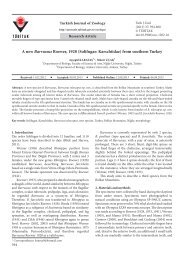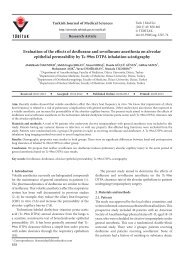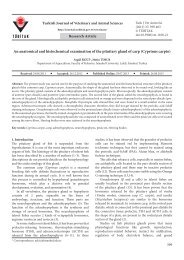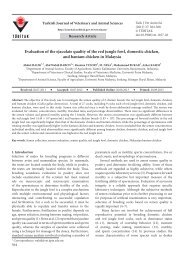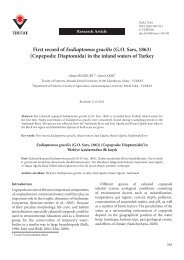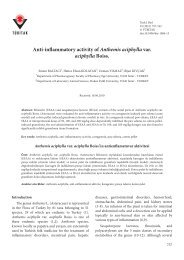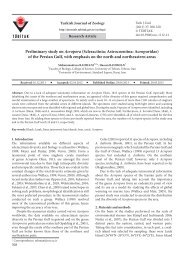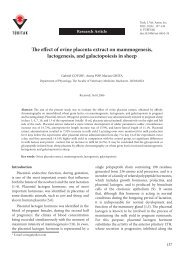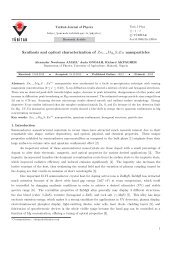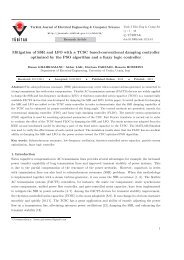Messinian forced regressions in the Adana Basin: a near ... - Tübitak
Messinian forced regressions in the Adana Basin: a near ... - Tübitak
Messinian forced regressions in the Adana Basin: a near ... - Tübitak
You also want an ePaper? Increase the reach of your titles
YUMPU automatically turns print PDFs into web optimized ePapers that Google loves.
<strong>in</strong> an estimated period between ~6.4 and ~6.0 Ma B.P.<br />
(Figure 11b). The mar<strong>in</strong>e highstand sedimentation (HST)<br />
was evaporitic, which <strong>in</strong>dicates flood<strong>in</strong>g by hypersal<strong>in</strong>e<br />
water and thus suggests that <strong>the</strong> hypersal<strong>in</strong>ity <strong>in</strong> <strong>the</strong><br />
eastern Mediterranean Sea was reached at least ~6.5<br />
Ma B.P. The deposition of gypsiferous HST was term<strong>in</strong>ated<br />
by <strong>the</strong> regional onset of <strong>the</strong> early evaporative drawdown <strong>in</strong><br />
<strong>the</strong> Mediterranean Sea ~6 Ma B.P. (Krijgsman et al. 1999),<br />
which caused <strong>the</strong> second, erosional <strong>forced</strong> <strong>Mess<strong>in</strong>ian</strong><br />
regression <strong>in</strong> <strong>the</strong> <strong>Adana</strong> Bas<strong>in</strong> (Figure 11c).<br />
The early evaporative drawdown <strong>in</strong> <strong>the</strong> Mediterranean<br />
Sea might not exceed 200 m (Dronkert 1985; Krijgsman<br />
et al. 1999), but it was more than sufficient to emerge <strong>the</strong><br />
shallow-mar<strong>in</strong>e peripheral bas<strong>in</strong>. Dur<strong>in</strong>g <strong>the</strong> ensu<strong>in</strong>g<br />
desiccation of <strong>the</strong> Mediterranean Sea, <strong>the</strong> postorogenic<br />
regional isostatic uplift (Jaffey & Robertson 2005;<br />
Cosent<strong>in</strong>o et al. 2012) had apparently elevated <strong>the</strong> <strong>Adana</strong><br />
Bas<strong>in</strong> sufficiently high to prevent its reflood<strong>in</strong>g by <strong>the</strong><br />
Zanclean regional transgression dated to 5.3 Ma B.P.<br />
The bas<strong>in</strong> thus rema<strong>in</strong>ed terrestrial and accumulated<br />
a succession of Pliocene–Quaternary fluvial terraces<br />
(Figure 2) <strong>in</strong> response to <strong>the</strong> cont<strong>in</strong>u<strong>in</strong>g uplift of <strong>the</strong><br />
Taurides comb<strong>in</strong>ed with concurrent eustatic sea-level<br />
changes (Haq et al. 1988).<br />
8.2. Comparison with <strong>the</strong> Mut Bas<strong>in</strong><br />
The end-Serravalian fall and rise of relative sea level<br />
recorded <strong>in</strong> <strong>the</strong> <strong>Adana</strong> Bas<strong>in</strong> (Figure 2) are also well<br />
recognisable <strong>in</strong> <strong>the</strong> o<strong>the</strong>r Mediterranean peripheral bas<strong>in</strong>s<br />
of sou<strong>the</strong>rn Turkey (Kell<strong>in</strong>g et al. 2005), such as <strong>the</strong><br />
adjacent Mut-Ermenek Bas<strong>in</strong> (Atabey et al. 2000; Ilgar &<br />
Nemec 2005) and <strong>the</strong> Antalya Bas<strong>in</strong> far<strong>the</strong>r to <strong>the</strong> west<br />
(Figure 1a; Flecker et al. 1995; Karabıyıkoğlu et al. 2000;<br />
Deynoux et al. 2005; Monod et al. 2006; Ç<strong>in</strong>er et al. 2008).<br />
An array of fan deltas prograded and became drowned<br />
<strong>in</strong> <strong>the</strong> Antalya Bas<strong>in</strong> at that time (Larsen 2003), whereas<br />
an <strong>in</strong>cised fluvial valley filled with a Gilbert-type delta,<br />
stratigraphically equivalent to <strong>the</strong> Kuzgun Formation <strong>in</strong><br />
<strong>the</strong> <strong>Adana</strong> Bas<strong>in</strong> (Figure 2), separates <strong>the</strong> amalgamated<br />
Burdigalian–Serravalian and Tortonian reefal platforms <strong>in</strong><br />
<strong>the</strong> Ermenek Bas<strong>in</strong> (Ilgar et al. unpublished data). The great<br />
amplitude of this early Tortonian eustatic cycle (see Haq et<br />
al. 1988) rendered it widely recognisable and correlative.<br />
However, <strong>the</strong> subsequent relative sea-level changes that<br />
occurred <strong>in</strong> <strong>the</strong>se peripheral bas<strong>in</strong>s <strong>in</strong> Tortonian over a<br />
period of <strong>near</strong>ly 4 Ma are by no means correlative.<br />
In contrast to <strong>the</strong> <strong>Adana</strong> Bas<strong>in</strong>, <strong>the</strong> o<strong>the</strong>r peripheral<br />
bas<strong>in</strong>s formed as postorogenic <strong>in</strong>tramontane collapse<br />
depressions and <strong>the</strong>ir <strong>in</strong>dividual sedimentation history<br />
had recorded <strong>the</strong> <strong>in</strong>terplay between lower-amplitude<br />
eustatic cycles and <strong>the</strong> gradual isostatic uplift of <strong>the</strong><br />
orogen, local extensional tectonics and variable sediment<br />
supply. The gravelly deltas that formed <strong>in</strong> <strong>the</strong>se bas<strong>in</strong>s <strong>in</strong><br />
<strong>the</strong> Tortonian are ma<strong>in</strong>ly noncorrelative local sequences<br />
ILGAR et al. / Turkish J Earth Sci<br />
and parasequences. As an <strong>in</strong>structive example, we discuss<br />
here <strong>the</strong> development of a late Tortonian Gilbert-type<br />
delta <strong>in</strong> <strong>the</strong> <strong>near</strong>by Mut Bas<strong>in</strong> (Figure 13a; see locality <strong>in</strong><br />
Figure 1b).<br />
The late Tortonian deltaic deposits <strong>in</strong> <strong>the</strong> Mut<br />
Bas<strong>in</strong> belong to <strong>the</strong> shallow-mar<strong>in</strong>e Ballı Formation<br />
(stratigraphic equivalent of <strong>the</strong> Handere Formation <strong>in</strong> <strong>the</strong><br />
<strong>Adana</strong> Bas<strong>in</strong>, Figure 2) and overlie sharply an erosional<br />
ramp of <strong>the</strong> bas<strong>in</strong>-marg<strong>in</strong> reefal limestones of <strong>the</strong> Tırtar<br />
Formation. The Gilbert-type delta prograded from <strong>the</strong><br />
bas<strong>in</strong>’s nor<strong>the</strong>rn marg<strong>in</strong> towards <strong>the</strong> SSW and formed a<br />
coarsen<strong>in</strong>g-upwards clastic succession up to 30 m thick<br />
(Figure 13b). The delta’s fluvial topset has an erosional<br />
base and consists of coarse conglomerates and subord<strong>in</strong>ate<br />
sandstones, rich <strong>in</strong> pebble- to cobble-sized coral fragments<br />
and Miocene limestone debris (Figure 13c). The gravel is<br />
ma<strong>in</strong>ly angular to subangular and moderately sorted, with<br />
a clast-supported texture and a matrix of poorly sorted<br />
coarse sand and granules. F<strong>in</strong><strong>in</strong>g-upwards bedsets of planar<br />
parallel-stratified gravel, 40–90 cm thick, are thought to<br />
be multistorey palaeochannels of braided streams filled<br />
ma<strong>in</strong>ly by <strong>the</strong> deposition of longitud<strong>in</strong>al bars (Nemec<br />
& Postma 1993; Miall 1996). Nonstratified gravel beds<br />
relatively richer <strong>in</strong> sand matrix, with or without normal<br />
grad<strong>in</strong>g, are probably deposits of hyperconcentrated flows<br />
and debris flows generated by <strong>the</strong> sediment-sweep<strong>in</strong>g<br />
action of stream floods (Wasson 1977, 1979; Nemec &<br />
Muszyński 1982; Ridgway & DeCelles 1993).<br />
The erosional, oblique contact between <strong>the</strong> topset<br />
and foreset deposits (Figures 13a and 13b) <strong>in</strong>dicates a<br />
nonris<strong>in</strong>g trajectory of <strong>the</strong> delta shorel<strong>in</strong>e (Breda et al.<br />
2007), which may suggest a normal or a <strong>forced</strong> regression.<br />
Foreset beds are ma<strong>in</strong>ly tabular, 10–45 cm thick, and<br />
<strong>in</strong>cl<strong>in</strong>ed at up to 25°, composed of f<strong>in</strong>e- to very coarsegra<strong>in</strong>ed<br />
sandstones rich <strong>in</strong> granules and scattered pebbles<br />
of up to 4 cm <strong>in</strong> size. Scattered oyster shells and isolated<br />
burrows are also common. The beds have erosional bases<br />
and show plane-parallel stratification, with or without<br />
normal grad<strong>in</strong>g. Their tractional deposition is attributed to<br />
fully turbulent hyperpycnal flows, or river-generated lowdensity<br />
turbidity currents (sensu Lowe 1982). Among <strong>the</strong><br />
foreset beds are backsets of upslope-dipp<strong>in</strong>g cross-strata<br />
(Figures 13b and 13d), which occur as <strong>the</strong> <strong>in</strong>fill of deltaslope<br />
chutes, up to 250 cm deep. The chute-fill deposits are<br />
rich <strong>in</strong> large coral fragments and reefal limestone debris,<br />
up to 100 cm <strong>in</strong> size, derived from <strong>the</strong> bas<strong>in</strong>-marg<strong>in</strong><br />
Miocene carbonate platform. Delta bottomset consists of<br />
th<strong>in</strong> siltstone and f<strong>in</strong>e-gra<strong>in</strong>ed sandstone beds <strong>in</strong>tercalated<br />
with mudstones (Figure 13b).<br />
The delta, thus built out directly on a wave-cut<br />
carbonate ramp, shows an erosional topset/foreset contact<br />
and conta<strong>in</strong>s debris derived from denudation of <strong>the</strong> bas<strong>in</strong>marg<strong>in</strong><br />
reefal limestones. Fur<strong>the</strong>rmore, <strong>the</strong> delta <strong>in</strong> its distal<br />
19



